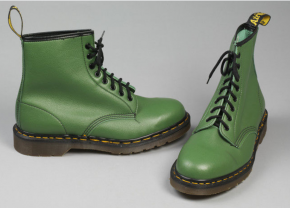This month Dr Martens has taken the plunge to float on the stock market at £3.5bn. This step ushers in a new era for the company, which has had a meteoric journey since it started 60 years ago as an orthopaedic footwear firm.
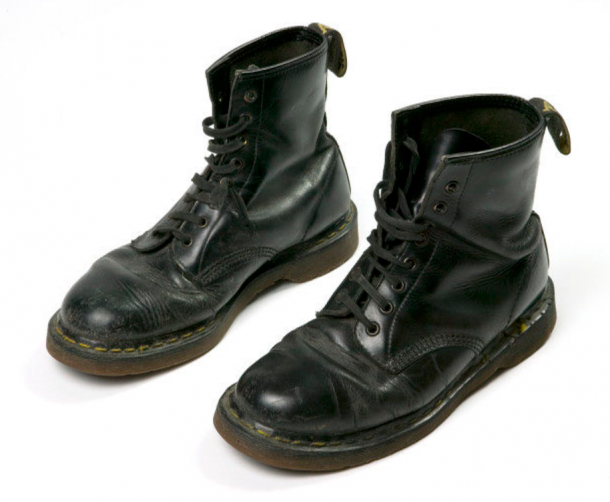
Doc Marten Boots by R Griggs Group Ltd. about 1980. Given by M. Harty. Museum No. B.78:1-1995
The first items I selected and accessioned into the V&A Museum of Childhood’s collection were a pair of Dr Martens boots. The little lace-up baby bootees were so small that they fitted in the palm of your hand. Made from super soft, padded leather, they featured a delicate pink and yellow floral design on a black background alongside the brand’s iconic hallmarks: the yellow stitching around the sole, the eyelets and black laces, plus the ‘AirWair’ looped tag at the heel. Soft, unsupportive, short-lived, novelty and decorative, these boots are almost the antithesis of the firm’s first hardwearing 1460 lace-ups. They are indicative of the remarkable route that the Dr Martens boot has made since it was launched.
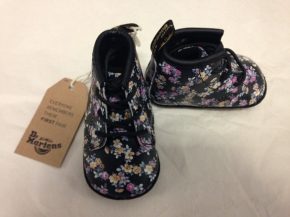
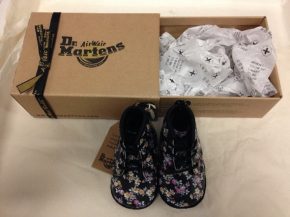
Boxed pair of Dr Martens boots for a child, about 2013 – 15. Museum no. B.39:1 to 7-2015
The original 1460 boot design, with its eight eyelets, air-cushioned ‘bouncing’ sole and yellow stitching was the brainchild of German and British designers. It was created by Bill Griggs, a shoemaker from Northamptonshire, who took inspiration from boots made by two German doctors, Dr. Klaus Maertens and Dr. Herbert Funk. The German pair had developed air-cushioned soles after Maertens injured his foot in 1945 and required more supportive and comfortable footwear. They repurposed ex-military stock and developed air-cushioned boots that they marketed at older women. Over the next decade, business boomed and they started advertising internationally. One of their adverts caught the attention of Bill Griggs – and by 1959 he had bought the license for Maertens’ bouncy soles. On 1 April 1960, he produced the now iconic 1460 boot, which takes its name from the date it was developed. Understanding the optics of post-War Britain, Griggs made the decision to Anglicise the name and the Dr Martens boots were born.
The boots’ durability and comfort made them a natural fit for people on their feet all day. Policemen, posties and factory workers adopted the 1460 boot. They even became part of the official uniform for London Underground workers. During the 1960s the robust and relatively inexpensive footwear became the staple of Britain’s working classes. It was the boot’s association with the working classes that made it appeal to subcultures, like Skinheads, Mods and Punks, who were looking both for a subversive symbolic fashion statement and to champion their working-class roots. The boots became the unofficial fashion accessory for those wanting to communicate their anti-establishment credentials, from Pete Townsend and Vivienne Westwood to the late Tony Benn MP.
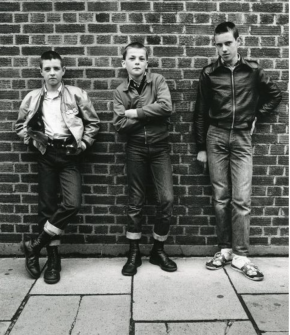
But the brand has not always enjoyed positive connotations. In the 1970s and 1980s the boots became associated with violent and anti-social groups, including Neo-Nazis who weaponised the protective steel toecaps. The brand also faced bankruptcy at the start of the millennium when sales slowed and the cost of production rose, but despite these challenges, the boots have continued to be embraced by all genders – and across diverse youth cultures from Britpoppers to Nu-Metallers. Their classic design has provided generations of wearers with a canvas for self-expression and customisation. The brand now even offers a bespoke ‘DIY DOCS’ customised service. The 1460 boot has become the unexpected staple of high-end fashion with celebrated collaborations with Vivienne Westwood, Raf Simons and Marc Jacobs. In 2018, Killing Eve’s fashion hungry antihero Villanelle playfully teamed a gossamer Burberry dress with the classic Dr Martens boots for her Italian villa assassination, epitomising the brand’s functional and fashionable appeal.
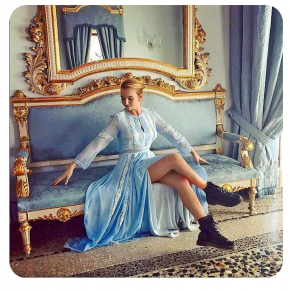
Despite concerns raised by long-term DM devotees over the boots’ production quality since the company moved much of its manufacturing to China in 2003, Dr Martens has continued to diversify and thrive. It has successfully navigated shifting fashion trends and developed new ranges such as their vegetarian lines, to appeal to more people. No longer are these boots the reserve of workers, rebels, Skinheads or the fashion-forward, they are now the fun footwear choice for children and the mass market. It is telling that Dr Martens has been one of the few clothing retailers who have seen growth during the pandemic, with sales of the footwear brand rising by almost 50% and with group profits almost doubling. And it is this burgeoning appeal which the brand is banking on as it makes its move this month into the global stock market.
